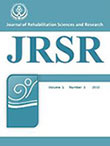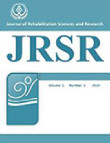فهرست مطالب

Journal of Rehabilitation Sciences and Research
Volume:2 Issue: 1, Mar 2015
- تاریخ انتشار: 1394/04/28
- تعداد عناوین: 5
-
Pages 1-7BackgroundFatigue can cause a significant effect on the mechanics of complex motor skills and reduce physical and mental efficiency. One of the common ways to reduce fatigue is passive recovering or using massage and cryotherapy after exercise. The present study aimed to compare the effects of massage and cryotherapy on muscles fatigue and isokinetic parameters.MethodsThis study was conducted on54 healthy athletes aged 20-30 years who were randomly divided into three groups: cooling (ice therapy), massage, and control (resting). Each of the volunteers was evaluated in two sessions. The first session was to familiarize the participants with isokinetic contraction. The second session started with a brief warm up subsequently, using Biodex Isokinetic System Average Peak Torque (APTQ), Average Power (AP), and Total Work (TW) were measured. Then, the fatigue protocol was applied. Afterwards, interventions were performed for 15 minutes. After the intervention, isokinetic parameters were evaluated again. Also, perceived fatigue and Fatigue Index (FI) were recorded before and after the intervention.ResultsAPTQ, AP, and TW significantlyincreased in massage and cryotherapy groupsafter the intervention, while perceived fatigue and FI decreased significantly in both conditions (P<0.05). In the control group, however, no significant differences were observed in APTQ, AP, and TW before and after the intervention (P>0.05), but perceived fatigue and FI decreased significantly (P<0.05). Moreover, isokinetic variables (APTQ, AP, and TW) were higher in the massage group compared to cryotherapy and control groups (P<0.05), but such a difference was not observed between the massage and cryotherapy groups (P>0.05).ConclusionMassage and cryotherapy could increase isokinetic parameters and decrease FI and perceived fatigue. Therefore, massage and cryotherapy have been more effective than rest as a strategy to return to normal state and no significant difference was observed between these two groups.Keywords: Muscle fatigue, Massage, Cryotherapy, Isokinetic, Rest
-
Pages 8-11BackgroundStudents encounter many stressful factors during their educational time. Stress can result in different physical and mental disorders such as depression. One intervention is using purposeful activity of gardening. The goal of this research is to investigate the effect of using purposeful activity (gardening) on depression of female resident in Golestan dormitory of Ahvaz Jundishapur University of Medical Sciences. This study was an experimental field research with pre and post tests in case controlled groups in the year of 2012-2013. Fifty depressed female students of Golestan dormitory in Ahvaz Jundishapur University of Medical Sciences participated in the study. Students were randomly allocated to case and controlled groups. Both groups were taken Beck Depression Inventory. Then gardening sessions (seed and small tree planting) were carried on in dormitory yard for 3 days a week for two months. Each session took approximately one hour. Both groups were assessed with the same questionnaire again after intervention.ResultsThe results showed a significant recovery after intervention in case group based on the depression scores (P= 0.0001).ConclusionAccording to this study, it seems that using purposeful activity of gardening has positive effects on decreasing depression in depressed female students.Keywords: Occupational therapy, Gardening, Depression, Students, Dormitory
-
Pages 12-16BackgroundCarpal tunnel syndrome is the most prevalent compression neuropathy of upper extremity which, two of the most important risk factors of that are the female sex and manual works. In the model of international classification of function, disability and health, disease is an impairment, results in functional limitation. The goal of this study is to compare hand function of participants between various severities of carpal tunnel syndrome.MethodsIn a cross-sectional study, during 6 months period of time, 30 housekeeper women with carpal tunnel syndrome, with the mean age of 47.03 years, were selected through simple sampling. They were assessed for hand function, by Purdue peg board test and Boston questionnaire, after that a professional practitioner had performed Nerve Conductive Velocity (NCV) test and identified the severity of their diseases. Then the data were analyzed with SPSS software, by Kruskal-Wallis test.ResultsThe mean of Purdue peg board test and Boston questionnaire scores in various clusters of carpal tunnel syndrome severity, were not different (P.Value>0.05).ConclusionIn this research, severity of electrodiagnostic findings of participants, with carpal tunnel syndrome, isnot related to their performance and functional limitations.Keywords: Impairment, Hand performance, Function, Carpal tunnel syndrome, ICF
-
Pages 17-19BackgroundJoint proprioception plays an important role in limb movement and awareness of position sense. Diabetes has a lot of complications such as lossof sensoryfunction, which canleadtoimpaired balance, thus the aim of this study to evaluated joint proprioception and balance in diabetic patients.MethodsTwenty type II diabetic patients and20healthy controls participated in this case-controlled study. Standing balance in various positions and ankle joint proprioception were measured. The data were analyzed using Mann-Whitney and chi-square test.ResultsIt was observed that the ankle joint proprioception and balance in diabetic patients were significantly less than control groups.(P<0.05)ConclusionJoint proprioception and balance functions impair in diabetic patients. Thus improvement of joint proprioception for prevention of fall is important.Keywords: Type 2 diabetes_Balance_Proprioception
-
Treatment of Myofascial Trigger Points of Pelvic Floor with Physiotherapeutic Package: A Case ReportPages 20-22BackgroundThere are various factors that may cause pain and dysfunction in the pelvic region. Myofascial trigger points can likewise contribute in pelvic pain. Common treatments for myofascial trigger points include electrotherapy, laser therapy, massage, ischemic compression, dry-needling, stretch, icing, heating, and biofeedback.Case report:A 26 year old man with an exertion-related pain that lasted 5 months was referred for physiotherapy consultation. He had no pain at rest but reported a referral pain from perineal region to the anus and muscular stiffness following a bout of physical activity. On palpation there was a trigger point in the perineal region with referral pain to anus. At the beginning of the treatment, the patient was asked to stop his physical activities. The patient received a treatment package which was useful in the management of trigger points. After 7 sessions of treatment the pain was diminished and there was no exercise induced stiffness. The patient was followed for 10 months later and no pain and stiffness was reported.ConclusionThe application of heat, friction massage, stretching, combined with endurance exercise could be an effective treatment for reliving the pain and muscular stiffness caused by trigger points.Keywords: Physiotherapy, Pelvic floor muscle, Perineal pain, Trigger point


